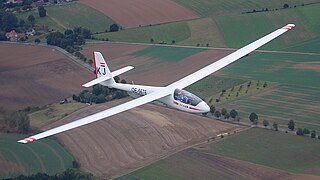Related Research Articles

The Schempp-Hirth Discus is a Standard Class glider designed by Schempp-Hirth. It was produced in Germany between 1984 and 1995 but has continued in production in the Czech Republic. It replaced the Standard Cirrus. It was designed by Klaus Holighaus.

The Schleicher ASW 15 is a single-seat sailplane designed in 1968 by Gerhard Waibel and manufactured by Alexander Schleicher GmbH & Co. The ASW 15 has shoulder-mounted wings and an all-flying tailplane, with its single tow-release placement a compromise between winching and aerotowing. The later ASW 15B had several improvements, including a tow-release placed on the plane of symmetry, an 11 cm taller rudder, a slightly larger main wheel, and the provision of a 90-litre water ballast system.
The Monarch B was a human-powered aircraft, designed and built by graduates and undergraduates of the Massachusetts Institute of Technology, and won the £20,000 first prize for the Kremer World Speed Competition. It is a successor to the Monarch A HPA which preceded it.

The Southampton University Man Powered Aircraft on 9 November 1961 became the first human-powered aeroplane to make an officially authenticated take-off and flight. It was designed and built by Southampton university students between 1960 and 1961 for an attempt at the Kremer prize, but it was never able to complete the 'figure-of-eight' course specified to claim the prize money.
The HPA Toucan is a British two-seat human-powered aircraft built and flown by members of the Hertfordshire Pedal Aeronauts and was the first two-person human-powered aircraft to fly.
The Akaflieg Darmstadt D-39 was a single-seat motor glider derived from the D-38 sailplane. Built in Germany in the late 1970s, it was not intended for production and only one was constructed.
The Akaflieg Braunschweig SB-8 is an experimental, single-seat, high performance glider built in Germany in the 1960s, constructed largely from glass fibre skin over built up balsa wood structure. Two were built; the second of which was later fitted with a high aspect ratio (30:1) wing, becoming the Akaflieg Braunschweig SB-9 Stratus.

The Mistral-C was one of the first gliders, designed in 1974 to the then new Club Class rules. It was based on the Strauber Mistral, a Standard Class glider flown a year earlier, but with a new wing and built from newer composite materials. Both types were designed and constructed in Germany. More than 75 Mistral-Cs were produced.
The Chrysalis was a human-powered biplane, designed and built by graduates and undergraduates of the Massachusetts Institute of Technology, with Professor Eugene Larabee acting as Project Adviser. MIT had previously built two HPAs, the BURD and BURD II, both of which were unsuccessful.
The IIL IS-10 was a high-performance, single-seat glider, designed and built in Romania in the early 1960s. It was the first Romanian aircraft to use laminar flow airfoils.

The ICA IAR-35 is a Romanian glider designed and built in the 1980s primarily for aerobatics, though capable of general purpose use. Several production prototypes were constructed.
The Goodhart Newbury Manflier was a two-place human-powered aircraft designed by Nicholas Goodhart. Its most notable feature was that the two pilots were placed in separate fuselages, spaced 70 ft apart.
The Wright MPA Mk 1 was the first of two human-powered aircraft designed and built by Peter Wright, an engineer from Melton Mowbray, England.
The HVS was a human-powered aircraft, designed and built by three German aeronautical professionals. Its name comes from the surnames of those involved; Wolfang Hütter, Franz Villinger, and Wilhelm Schüle. Villinger co-designed the 1930s HV-1 Mufli human-powered aircraft.
The Olympian ZB-1 was the first human-powered aircraft to have flown in the United States. It was designed, built, and flown by Joseph A. Zinno, of North Providence, Rhode Island. Zinno had previously been a USAF Lieutenant Colonel, and undertook the challenge of making a human-powered aircraft as a post-retirement project.
The BURD was a two-place human-powered biplane, designed and built by graduates and undergraduates of the Massachusetts Institute of Technology, with Professors Eugene Covert and James Mar acting as project advisers. It was developed with the specific goal of winning the £50,000 Kremer prize then on offer.
The Monarch A was a human-powered aircraft, designed and built by graduates and undergraduates of the Massachusetts Institute of Technology, with Professors Walter Hollister and Ed Crawley acting as Project Advisers. Professor Eugene Larrabee, who had been the adviser for the 1979 MIT Chrysalis HPA, also provided support.
The LP Dedal-2 human-powered aircraft was the project of Leon Polniak, a Franco-Polish engineer based in Kraków, Poland, and was a development of his earlier, unfinished, Dedal design. Dedal is Polish for Daedalus.
The Dragonfly was a human-powered aircraft, designed and built by the Prestwick Man Powered Aircraft Group, based at the Prestwick International Airport in South Ayrshire, Scotland.
The Halton Jupiter was a human-powered aircraft which established distance and duration records in the early 1970s.
References
- 1 2 Taylor, John W. R., ed. (1976). Jane's all the world's aircraft 1976-77. London: Macdonald and Jane's Publishers Ltd. pp. 521–522. ISBN 0354005383 . Retrieved April 9, 2023.
- ↑ Dwiggins, Don (1977). Man-powered aircraft. Blue Ridge Summit, PA: Tab Books. pp. 165–167. ISBN 0830622543.
- 1 2 3 Langford, John (Spring 1981). "Not All Student Design Projects End on Paper: Chronology of the Chrysalis". AIAA Student Journal. Vol. 19, no. 1. New York, NY: American Institute of Aeronautics and Astronautics. pp. 4–13. Retrieved April 9, 2023.
- 1 2 Dorsey, Gary (1990). The Fullness of Wings: The Making Of A New Daedalus. New York, NY: Viking. pp. 40–49. ISBN 0670824445.